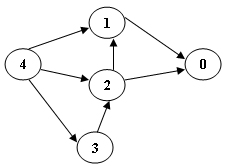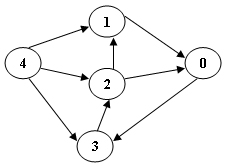Write a program to find the topological order in a digraph.
Format of functions:
bool TopSort( LGraph Graph, Vertex TopOrder[] );where LGraph is defined as the following:
typedef struct AdjVNode *PtrToAdjVNode;
struct AdjVNode{
Vertex AdjV;
PtrToAdjVNode Next;
};
typedef struct Vnode{
PtrToAdjVNode FirstEdge;
} AdjList[MaxVertexNum];
typedef struct GNode *PtrToGNode;
struct GNode{
int Nv;
int Ne;
AdjList G;
};
typedef PtrToGNode LGraph;The topological order is supposed to be stored in TopOrder[] where TopOrder[i] is the i-th vertex in the resulting sequence. The topological sort cannot be successful if there is a cycle in the graph – in that case TopSort must return false; otherwise return true.
Notice that the topological order might not be unique, but the judge’s input guarantees the uniqueness of the result.
Sample program of judge:
#include <stdio.h>
#include <stdlib.h>
typedef enum {false, true} bool;
#define MaxVertexNum 10 /* maximum number of vertices */
typedef int Vertex; /* vertices are numbered from 0 to MaxVertexNum-1 */
typedef struct AdjVNode *PtrToAdjVNode;
struct AdjVNode{
Vertex AdjV;
PtrToAdjVNode Next;
};
typedef struct Vnode{
PtrToAdjVNode FirstEdge;
} AdjList[MaxVertexNum];
typedef struct GNode *PtrToGNode;
struct GNode{
int Nv;
int Ne;
AdjList G;
};
typedef PtrToGNode LGraph;
LGraph ReadG(); /* details omitted */
bool TopSort( LGraph Graph, Vertex TopOrder[] );
int main()
{
int i;
Vertex TopOrder[MaxVertexNum];
LGraph G = ReadG();
if ( TopSort(G, TopOrder)==true )
for ( i=0; i<G->Nv; i++ )
printf("%d ", TopOrder[i]);
else
printf("ERROR");
printf("\n");
return 0;
}
/* Your function will be put here */Sample Input 1 (for the graph shown in the figure):
5 7
1 0
4 3
2 1
2 0
3 2
4 1
4 2Sample Output 1:
4 3 2 1 0Sample Input 2 (for the graph shown in the figure):
5 8
0 3
1 0
4 3
2 1
2 0
3 2
4 1
4 2Sample Output 2:
ERROR思路:
拓扑排序,题目代码没求各点的入度,这个自己求。
代码:
int In[MaxVertexNum];//存储各点入度
bool TopSort( LGraph Graph, Vertex TopOrder[] ){
memset(In,0,sizeof(In));
for(int i=0 ; i<Graph->Nv ; i++){
PtrToAdjVNode t = Graph->G[i].FirstEdge;
while(t){
In[t->AdjV]++;
t = t->Next;
}
} //求各点入度
int queue[Graph->Nv]; //建立队列存储入度为零的点
int head,tail;
head = tail = 0;
for(int i=0 ; i<Graph->Nv ; i++){
if(In[i] == 0){
queue[tail++] = i;
break;
}
} //找第一个入度为零的点
int index = 0;
while(head<tail){
int node = queue[head++];
TopOrder[index++] = node;
PtrToAdjVNode t = Graph->G[node].FirstEdge;
while(t){
In[t->AdjV]--;
if(In[t->AdjV] == 0)queue[tail++] = t->AdjV;
t = t->Next;
}
}
if(index == Graph->Nv)return true;
else return false;
}






















 443
443











 被折叠的 条评论
为什么被折叠?
被折叠的 条评论
为什么被折叠?








